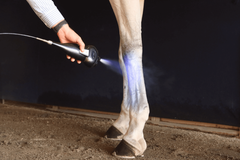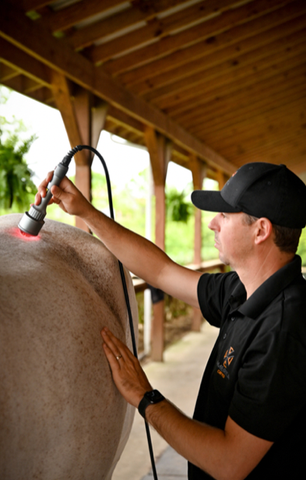Managing and Preventing Common Injuries in Sports Horses
Managing and Preventing Common Injuries in Sports Horses
It’s no secret that horse sport pushes the boundaries of both the horse and rider’s physical capabilities. It takes an extreme amount of fitness and exertion to perform the tasks we ask of them, whether that’s over fences, in the dressage arena, or winding around the barrels. As a result, sports horses are inherently more prone to injury, some of which can be potentially career-halting.
Keeping these impressive horses on the road is not a part-time job and requires a lot of knowledge and time to make sure they’re fit and feeling their best. Pushing horses to perform when they aren’t ready or feeling a little ‘off’ will only exacerbate any underlying weakness and risk a larger, more serious, injury occurring.
Just like us, horses have strengths and weaknesses throughout their bodies. For example, some horses may take more strain on their forelimbs due to their conformation and are pre-exposed to lower forelimb damage. They may also have stronger or weaker sides, just like we are right or left-handed. So, it’s really important to listen and understand your horse to know when and how to push them, and also when to ease off the gas.
As our understanding of anatomy and science has evolved, we now have the knowledge to support these horses and treat any minor flare-ups to prevent them from becoming a significant injury. Knowing how best to manage and support these horses, even when they’re performing at their best, is the key to ensuring a long-lasting and successful career. Keep reading for some of our favorite management tips…
Common injuries in sports horses

Unfortunately, there are a lot of ways horses can sustain injuries or damage doing the jobs they do. And quite often, if a horse is presenting with multiple weaknesses or ailments, they’re probably all connected. That’s why it’s so important to manage any small niggles that arise quickly, so they aren’t training and competing past a sustainable threshold.
Soft tissue damage is the number 1 injury that halts a horse’s career in its tracks. Horses have no muscle beneath the knee, so the lower limbs are made up entirely of bone and soft tissues, like ligaments and tendons. These structures are vital for a horse to do its job, and running them with any damage, however minor, will worsen and lead to significant discomfort and time off. These soft tissues can be damaged through repetitive strain, an acute injury (such as a nasty overreach or field accident), or conformationally. Soft tissue injury will often show swelling, heat, and pain upon palpation in the suspected area as well as lameness.
Deterioration of the joints is another big ailment sport horses face. Over time, the repetitive exertion will take its toll on the horse’s body, and wear and tear to the joints will occur. The stifles and hocks are the most common joints to bear the brunt of hard work, and dressage and jumping horses are susceptible to strain on their sacroiliac (SI) joints too. Often, as joints begin to deteriorate it puts extra strain on the soft tissues in the leg and can lead to further damage. So those two injuries frequently go hand in hand. Catching signs of joint stiffness or soreness early on can help to prevent further damage to the structures.
Like all athletes, human or horse, the muscles face a considerable workout. Strains and tears are very common in performance horses and often occur when a horse is pushed without an adequate warm-up. Just like their human counterparts, horses need a suitable warm-up to get their muscles loose and ready for exercise. A horse’s back is typically where you see the most muscle soreness and tightness here can stem throughout the body and hinder movement, causing several other issues. Tack can significantly impact how a horse uses their body, so having a saddle that fits well is a necessity for preventing back pain, muscle strain, and other injuries.
How to manage and prevent sport horse injuries
There are several ways to treat injuries in competition horses as they arise, and some things to put into practice to ensure you’re doing your best to prevent unnecessary injury from occurring. Knowing what to look out for and how to manage your horses, even when there is no prominent injury is the best way to keep them feeling fit and on the road to success.
- Bandaging
Bandaging after intense exercise or competition has long been a great hack to maintaining sport horse’s legs. Bandaging will help prevent swelling, either of the limb as a whole or an acute injury, which has shown a positive effect on the maintenance and outcome of injuries. Bandaging is most effective with a bandage pad and appropriate pressure. It’s vital to ensure that the pressure remains even down the length of the leg and no areas are tighter or looser than others.
2. Ice/cold therapy

Applying ice or cold hosing is a fantastic trick to reduce the heat in any injury in the lower leg. Even if there is no injury present, it’s a good practice to get into after significant exertion to ensure the recovery of soft tissues and help remove any residual heat from the leg.
If you want to go one step further, cryotherapy is proven to be highly effective in reducing inflammation, and pain, and boosting recovery time. A thermal ‘shock’ triggers the horse’s sensory neuroreceptors which elicits a corrective reflex from their central nervous system. It’s highly effective and widely used by professionals, vets, and equine therapists, so if you’re looking for a cold therapy with instant effects then Subzero Equine Cryotherapy is what you’re looking for.
3. Regular treatment
Having an osteopath, physiotherapist, or equine specialist treat your horse regularly is a great way to stay on top of their overall condition and physical health. They will be able to tell if your horse is sore anywhere or their muscles are feeling the strain, as well as recommend some stretches or exercises to build up their muscles and fitness. Even if your horse is feeling great, it’s always good practice to have a routine check-up by your preferred equine specialist to keep them in tip-top condition and make sure they’re feeling and performing at their best.

Some equine specialists will use laser technology to stimulate the healing and recovery process. Lasers have become a popular choice amongst veterinary professionals because of their ability to target the innermost structures with infrared light, causing biomechanical changes and stimulating wound repair. It’s a safe, effective, and efficient way to treat damage to soft tissues and reduce localized swelling and pain.
4. Rest
Giving horses enough time to rest and recover is super important for their overall performance as well as ensuring any injuries have sufficient time to heal. It may be frustrating, but time off and possibly box rest can be one of the most effective treatments for any injury. Continuing to work them hard will worsen whatever is under the surface and you may push it too far to heal properly. If you suspect an injury, consult your vet, and follow their advice. Using laser treatment, like the Tri Laser or Quad Laser, alongside rest and rehabilitation will give your horse the best chance of recovery.
5. Correctly fitting tack

Having a well-fitting saddle and tack that doesn’t restrict or hinder a horse’s movement is a vital way to keep horses happy in their workload. A horse’s back is the epicenter of movement, so a sore back is likely to create problems felt throughout the body.
For example, if a horse is not using its body correctly because the saddle is pinching them, then they will be putting unnecessary strain on other structures throughout their body, increasing the risk of injury. Not to mention they will be very uncomfortable! Having a saddle that fits properly and works with the horse is super important to prevent unnecessary injury, particularly for sports horses who wear their saddle multiple times a week!
If you’re keen to learn more about how cryotherapy and laser treatment can help your horse, or you’re a veterinary professional or rehab specialist looking to introduce some new treatment to your retinue, then head over to America Cryo to find out more. America Cryo is dedicated to supporting top riders, trainers, and industry professionals to keep our equine athletes competing at the top of their sport.
Have a question about your saddle or haven’t found the perfect fit yet? Lilly Tay will be happy to assist you with any of your saddle queries or concerns. Head over to the website to get in touch so that we can get started.
